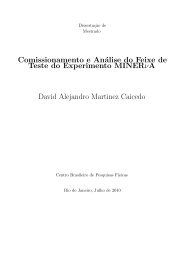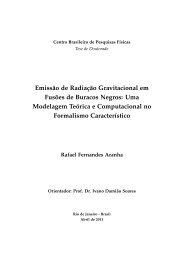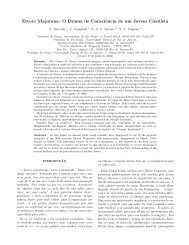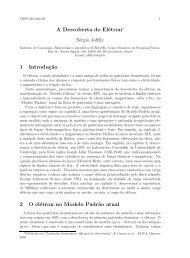Sistema multicanal para aquisiç˜ao de dados em um ... - CBPFIndex
Sistema multicanal para aquisiç˜ao de dados em um ... - CBPFIndex
Sistema multicanal para aquisiç˜ao de dados em um ... - CBPFIndex
Create successful ePaper yourself
Turn your PDF publications into a flip-book with our unique Google optimized e-Paper software.
Abstract<br />
This work is a contribution to the <strong>de</strong>velopment of instr<strong>um</strong>entation for the MonRAt<br />
experiment (acronym for “Atmospheric Radiation Monitor”, in Portuguese), which is a<br />
compact telescope that aims to measure the fluorescence radiation caused by interaction<br />
of ultra-high energy cosmic rays (between 10 18 eV and 10 20 eV ) in the atmosphere. The<br />
experiment uses the multianodic photomultipliers technology (with 64 pixels) as a fluorescence<br />
radiation sensor. The acquisition syst<strong>em</strong> <strong>de</strong>veloped is composed of hardware,<br />
firmware and software el<strong>em</strong>ents. The hardware is composed of 16 FPGA-based data processing<br />
modules <strong>de</strong>veloped in CBPF, providing 64 analog input channels, sampling rate<br />
60 MSPS and 128 channels for time interval measuring, with resolution down to 120 ps.<br />
The firmware <strong>de</strong>scribes two architectures of logic circuits, which have been <strong>de</strong>veloped and<br />
impl<strong>em</strong>ented in one FPGA. The acquisition program was <strong>de</strong>veloped for Linux, written in<br />
C++ language, using the ROOT framework. It manages the acquisition process, configures<br />
the hardware and receives data through USB ports. Data can be displayed in real time<br />
and can also be saved in text files. All the syst<strong>em</strong>s are <strong>de</strong>scribed, as well as results of the<br />
characterization of the acquisition channels and measur<strong>em</strong>ents for gain <strong>de</strong>termining of the<br />
photomultiplier pixels by two different methods: single photoelectron and photostatistic.<br />
vii
















